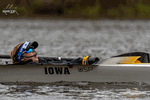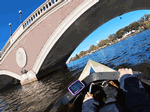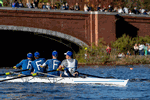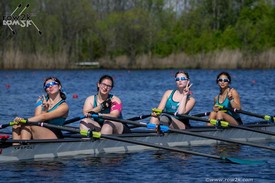In the Driver's Seat, with Natalie Cleri
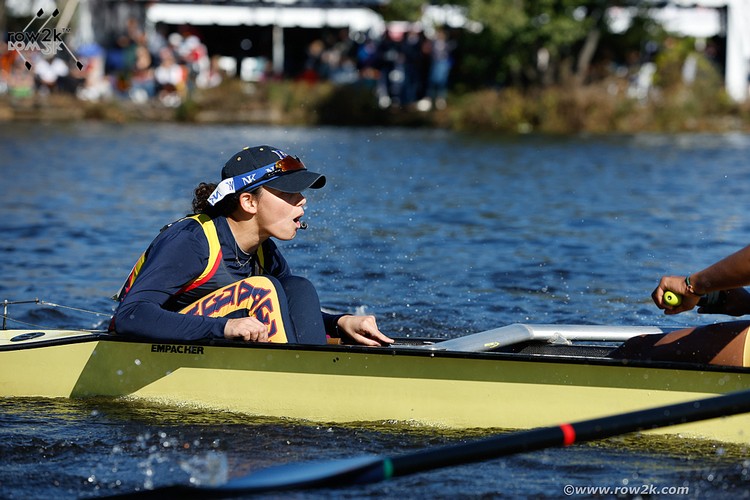
Next up In The Driver's Seat--where we hear from the folks who keep the shells straight and the crews fast—-is coxswain Natalie Cleri.
Natalie coxes the Women's Varsity Eight at Drexel University, where she has steered the Dragons to wins at the Dad Vail, as well as the Kerr and Kelly Cups on the Schuylkill. She started coxing in high school at Our Lady of Mercy Academy in Syosset, New York.
She was at the helm when Drexel won the Club Eight at the Charles in 2022, and when the Drexel Varsity led the early going of the Grand Final of the 2022 CAA Championships against Northeastern. In all, Natalie has won three CAA silver medals in the Drexel's top boat and been part of the most successful teams the Dragons have fielded in recent years at their conference championship.

Let's hop In The Driver's Seat with Natalie:
row2k - What do you see as the three most important things for being a successful coxswain?
Natalie Cleri - Here are the 3 most important things to be a successful coxswain:
Steering: There are 3 things to do in order to steer well.
1. Be able to steer any boat that you are put in (ex. 4+, 8+, Vespoli, Empacher). No matter the boat class or boat shell on any given day, the first thing to do is figure out the boat's steering mechanism and its responsiveness.
2. Know your high point and know your low point. When you are trying to maneuver a boat, have a high point in the sky and a low point on the water that you can repeatedly check in on to make sure that you are going straight and are on course.
3. Wrap your fingers around the gunwale. However many you can fit around the gunwale, do it. The more grip you have on the gunnel, the smaller your movements will be when using the rudder and that will keep the boat set and pointed where it needs to go without overdoing it.
Execution/Boat Management: On any given day, the most successful coxswains are the ones who efficiently led their crew through a practice or a race the way the coach intended it to go. Whatever the workout is for that day, have a strong grasp on every detail. Be one step ahead. During a practice, if you are in a situation where you know what to do to keep your crew safe and keep the practice running smoothly and efficiently, do it. If you don’t know what to do in any given moment, be aware of your surroundings and ask at the right time. All in all, if you help run the practice safely and effectively, your rowers and coaches can focus on their own responsibilities, creating a trusting and harmonious environment.
Keep it clear and keep it simple: When trying to keep your rowers composed and internal, the best thing to do is keep things as consistent and concise as possible. Do not overcomplicate it. Avoid saying wordy phrases and avoid implementing too many focuses at once. The clearer and simpler you are, the more effective your calls can be.

row2k - What is your favorite drill to run with your crews? Any tips on how to the drill well, for maximum effectiveness?
Natalie Cleri - I know it seems simple, but one of my favorite drills is Outside Arm Only, on the square. This drill is usually done by 4s or by 6s, where the rowers row with only their outside hand on the oar handle and their inside hand either on top of their thigh or with a fist on top of the handle. I like this drill is because it is simple, but very effective.
As a coxswain, to keep your crew doing this drill well, the most important thing is to keep the crew focused. This drill can help with numerous focuses and technical points in the stroke. By being on the square, this drill helps with handle height on the recovery and depth in the water on the drive. To be most effective in setting your boat, the best thing to use is the outside hand rather than the inside one.
By emphasizing the outside hand, this drill also helps the rowers the engage their lat muscles, keep relaxed shoulders, and focus on completing the stroke all the way through the water with a flat outside wrist. Outside Arm Only on the square helps posture, engagement, set, and overall boat speed.
row2k - What's some of the best coaching advice you've received about your coxing?
Natalie Cleri - The best coaching advice I have ever received about my coxing has come from my current coach, Asiya Mahmud. I attribute so much of my current knowledge and skill to her.

Being a coxswain is difficult, it is not an easy task. There are a lot of responsibilities and tasks to manage as a coxswain at any level. At the higher levels, the changes you need to make to go from collegiate to elite, or from good to great, are very small. Some of the best advice Coach Mahmud has ever given me as I have grown and improved as a coxswain are these two things:
"As much as you're thinking about one thing you are doing wrong, you are also doing a lot of things right" and "Try not to wear your heart on your sleeve."
These two pieces of advice have made a world of difference in my coxing this spring for so many reasons. I am an emotional person; I care a lot about what I do. While that caring nature makes me a better person and a better coxswain, the more collected and emotionally composed I can stay, the better my boat's speed will be.
Both pieces of advice can also be applied to constructive criticism and feedback. It is important to know that corrections and comments that you receive on the water and on land are not personal, they are to better yourself and better your crew. At the end of the day, that is the most important. Coach Mahmud never fails to remind me of this when it's needed to be heard the most.
row2k - What is a mid-race call or move that you've made that you'll remember for the rest of your life? If so, what did it involve and how did you call it? Natalie Cleri - A mid-race call that I made that I will remember for the rest of my life is, "Why Not?" This specific call is one that I love making, but it must be implemented at the right time.

Earlier this season, our Drexel Women's team had the opportunity to race in Sarasota at Nathan Benderson Park for the Sunshine State Invitational. The teams that enter in this race are fast and see speed all the time. Because of that, it is always exciting to see how we can do so early into our spring season. To set the scene, I made this call going into the last 500 meters of the Grand Final of the Invitational. We had met our goal of qualifying for the Grand Final and had nothing to lose. We were one of three boats tied for 3rd place, and in contention for a medal. During this part of the race, I called a move for us to walk, but what I said following that was "because WHY NOT."
My crew was extremely responsive, and we were able to all were able to walk up on two highly ranked teams to take 3rd and medal. Not only was it important for me to know my crew's capabilities at this point in the race, but it was also important that I had implemented calls like that at practice. That memorable call wasn't just in the moment: it was made and earned through planting seeds of that energy and phrasing at practice. "Why not?" is such a powerful phrase because so much is said in so few words: What do we have to lose? What/who is stopping us? What says we are not capable of what we previously thought to be impossible? Nothing.

row2k - Can you tell us anything about what you've learned about how to call the sprint?
Natalie Cleri - The sprint of a race is interesting to me. It is the part of a race that is the most cheered for and watched by spectators and fans, and yet how you go into it and come out of it across the finish line is mostly dictated by your execution in the other 1500+ meters of the race.
That being said, there are a three things that I have learned are helpful in the sprint of a race.
1. Know your goal. Whatever your goal placement or goal time is, have a good sense of it and make sure your crew knows what it is going to take to get there if you are not there already.
2. Know your crew and its identity. What does your specific crew need to hear to get them to push themselves harder than they thought they could? Know what words, phrases, or tones are the most effective.
3. Keep them present. By this point of a race, a lot of rowers are dizzy or "blacked out." Keep them present and draw them back in. If that means saying some of their names, then do it.
row2k - Tell us about the best race/practice you've ever had?
Natalie Cleri - One of the best races of my life was the Head of The Charles in October 2022. I was 1 of the 9 crew members of the Drexel Women's Varsity 8+ to take 1st place in the Women's Club 8+ category. What an honor. It was the most fun and most memorable races of my life so far, and it took a lot of hard work and dedication to get there.

I have been studying the Head of the Charles course since 2012. That year, I had been a spectator of the regatta and overheard an announcer say, "This is a coxswain's race." I took these words to heart, and I knew that one day, if I were given the opportunity to cox at HOCR, I would do everything in my power to help my boats be successful. Never in a million years would I, then a 13 year old, have thought that I would be a future HOCR champion.
2022 was my 5th time race at the Head of the Charles. Because we had not raced at HOCR the previous year, our bow number going into the race was #30. If you know the HOCR, you know that being behind 29 other crews is not optimal. I knew the course like the back of my hand. I knew, and my rowers and coaches knew, that I was not going to let bow #30 stop us from having the best course/line possible and we ALL had trust in that.
Another thing I did in preparation for the race, with my coaches and my crew, was use the race's timestamps to track how fast we needed to get to each location to win the race. We hit those timestamps and then some. We hit the lines on the course like we owned it and drew it out of ourselves. All 9 of us worked together during that race, mind and heart, and put every single effort we had into it. We crossed the line, after having passed numerous crews, knowing that we did well. We knew we were fast; we just didn't know how fast.
Coming back to the dock, where our coaches and teammates and parents were waiting for us to break the news that we had gotten 1st was the most surreal moment. I could not believe it, and I still can't believe. But at the same time, knowing the level of training and effort that went into it, we did it.
Thanks for riding along with Natalie -- and, remember, this column is open to all "drivers" out there, so if you are an experienced coxswain at any level--from juniors to masters--and would be willing to invite row2k to join you in your ride, just contact us here. We’d love to hear from you about what you see from the Driver's Seat.
If you enjoy and rely on row2k, we need your help to be able to keep doing all this. Though row2k sometimes looks like a big, outside-funded operation, it mainly runs on enthusiasm and grit. Help us keep it coming, thank you! Learn more.
Comments | Log in to comment |
There are no Comments yet
| |
- Bont Rowing
- Calm Waters Rowing
- Concept 2
- Craftsbury Sculling
- The Crew Classic
- CrewLAB
- Croker
- Dad Vail Regatta
- Durham Boat Co.
- Empacher
- Faster Masters
- Filippi
- Fluidesign
- h2row.net
- HUDSON
- Live2Row Studios
- Nielsen-Kellerman
- Oak Ridge RA
- Peinert Boat Works
- Pocock Racing Shells
- Race1 USA
- Rockland Rowing Masters Regatta
- RowKraft
- Rubini Jewelers
- Vespoli USA
- WinTech Racing
- Bont Rowing
- Calm Waters Rowing
- Concept 2
- Craftsbury Sculling
- The Crew Classic
- CrewLAB
- Croker
- Dad Vail Regatta
- Durham Boat Co.
- Empacher
- Faster Masters
- Filippi
- Fluidesign
- h2row.net
- HUDSON
- Live2Row Studios
- Nielsen-Kellerman
- Oak Ridge RA
- Peinert Boat Works
- Pocock Racing Shells
- Race1 USA
- Rockland Rowing Masters Regatta
- RowKraft
- Rubini Jewelers
- Vespoli USA
- WinTech Racing



